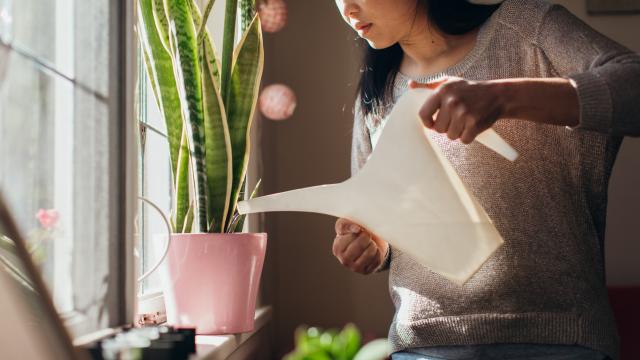So, it’s getting cooler and your plants are a bunch of fussy jerks. Naturally, because you’re a caring plant parent, you’re concerned about their well-being as the weather turns.
The question is: should you switch up your plant care routine? Or is it best to remain steadfast? Lucky for you (and me) Bunnings has some advice.
To start, check to see if your plants have any damage to them:
Over the warmer months, it’s not uncommon that plants experience a bit of a rough time. The team at Bunnings recommends kicking off the cooler part of the year by checking for any damage to your plants that may need to be addressed.
“Plants that have suffered from water stress through the heat of summer may have burnt leaves or have partially defoliated,” Bunnings shares.
“A light trim, fertilise, mulch and deep regular watering will help promote healthy new growth…”
You may need to check how much sunlight your plants are getting
With the cooler months, we’re obviously getting less sunlight so pay attention to what your plants need in that regard. Bunnings advises that if your plants are in a “dark position” you should move them into “a location where they can get some indirect light [that] will help keep them healthy and lush”.
“It is always beneficial to rotate house plants so they have even bushy growth.”
This is actually a great time to start planting
If you’ve got access to some indoor-friendly herbs like coriander, parsley, or mint, this is the perfect time to give them a go. And those of you who are lucky enough to also have access to an outdoor garden, this is a great time to consider planting some veggies.
As the Bunnings website writes:
Throughout autumn and winter, “The sun may be largely on vacation, but there are still some plants that benefit from being planted at this time of year, including bare root trees, winter vegetables and colour”.
In a statement on cooler climate plant care, Bunnings wrote that this is the ideal time to plant “brassica vegetables such as cabbage, cauliflower and broccoli. Try some leafy greens like lettuce, spinach and silverbeet. Onions and peas also work well…”
Autumn and winter are also said to be great seasons for planting yourself a citrus tree if you have the space available.
Watch the temperature
If you’re one who tends to be a little generous with the heater settings over winter, be sure to consider the comfort of your plants. Better Homes and Gardens shares that heating up your home too much can be detrimental to the health of your plant babies. It can also lead your plants to dry out. If that’s the case, add in more moisture by misting your plants with a water spray bottle.
BHG also shares that areas like the kitchen or bathroom may be better environments for plants that enjoy high humidity (like ferns or prayer plants).
Just be sure not to over-water. You may find your plants need less water over the coming months – but the best way to check that is by popping a finger in the soil and feeling for moisture levels.
Good luck!

Leave a Reply
You must be logged in to post a comment.